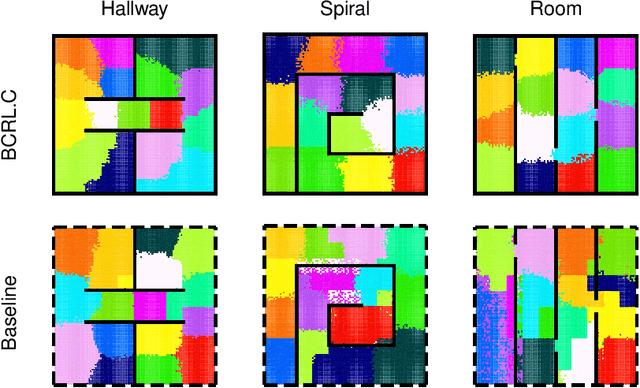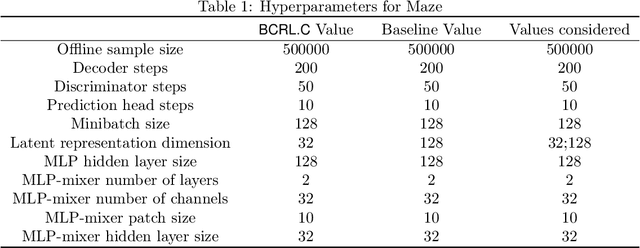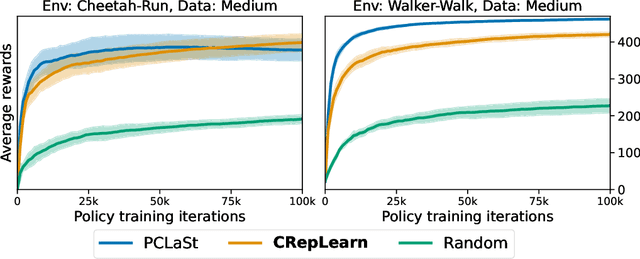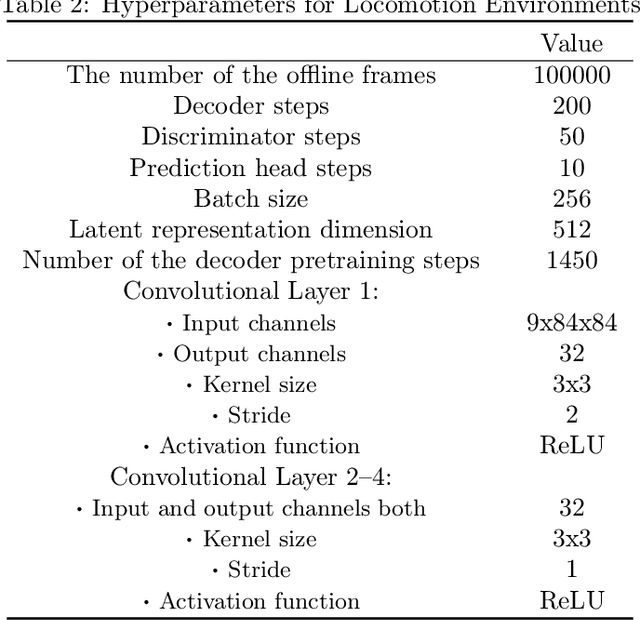Akshay Krishnamurthy
Carnegie Mellon University
The Role of Environment Access in Agnostic Reinforcement Learning
Apr 07, 2025Abstract:We study Reinforcement Learning (RL) in environments with large state spaces, where function approximation is required for sample-efficient learning. Departing from a long history of prior work, we consider the weakest possible form of function approximation, called agnostic policy learning, where the learner seeks to find the best policy in a given class $\Pi$, with no guarantee that $\Pi$ contains an optimal policy for the underlying task. Although it is known that sample-efficient agnostic policy learning is not possible in the standard online RL setting without further assumptions, we investigate the extent to which this can be overcome with stronger forms of access to the environment. Specifically, we show that: 1. Agnostic policy learning remains statistically intractable when given access to a local simulator, from which one can reset to any previously seen state. This result holds even when the policy class is realizable, and stands in contrast to a positive result of [MFR24] showing that value-based learning under realizability is tractable with local simulator access. 2. Agnostic policy learning remains statistically intractable when given online access to a reset distribution with good coverage properties over the state space (the so-called $\mu$-reset setting). We also study stronger forms of function approximation for policy learning, showing that PSDP [BKSN03] and CPI [KL02] provably fail in the absence of policy completeness. 3. On a positive note, agnostic policy learning is statistically tractable for Block MDPs with access to both of the above reset models. We establish this via a new algorithm that carefully constructs a policy emulator: a tabular MDP with a small state space that approximates the value functions of all policies $\pi \in \Pi$. These values are approximated without any explicit value function class.
Is Best-of-N the Best of Them? Coverage, Scaling, and Optimality in Inference-Time Alignment
Mar 27, 2025



Abstract:Inference-time computation provides an important axis for scaling language model performance, but naively scaling compute through techniques like Best-of-$N$ sampling can cause performance to degrade due to reward hacking. Toward a theoretical understanding of how to best leverage additional computation, we focus on inference-time alignment which we formalize as the problem of improving a pre-trained policy's responses for a prompt of interest, given access to an imperfect reward model. We analyze the performance of inference-time alignment algorithms in terms of (i) response quality, and (ii) compute, and provide new results that highlight the importance of the pre-trained policy's coverage over high-quality responses for performance and compute scaling: 1. We show that Best-of-$N$ alignment with an ideal choice for $N$ can achieve optimal performance under stringent notions of coverage, but provably suffers from reward hacking when $N$ is large, and fails to achieve tight guarantees under more realistic coverage conditions. 2. We introduce $\texttt{InferenceTimePessimism}$, a new algorithm which mitigates reward hacking through deliberate use of inference-time compute, implementing the principle of pessimism in the face of uncertainty via rejection sampling; we prove that its performance is optimal and does not degrade with $N$, meaning it is scaling-monotonic. We complement our theoretical results with an experimental evaluation that demonstrate the benefits of $\texttt{InferenceTimePessimism}$ across a variety of tasks and models.
Computational-Statistical Tradeoffs at the Next-Token Prediction Barrier: Autoregressive and Imitation Learning under Misspecification
Feb 18, 2025Abstract:Next-token prediction with the logarithmic loss is a cornerstone of autoregressive sequence modeling, but, in practice, suffers from error amplification, where errors in the model compound and generation quality degrades as sequence length $H$ increases. From a theoretical perspective, this phenomenon should not appear in well-specified settings, and, indeed, a growing body of empirical work hypothesizes that misspecification, where the learner is not sufficiently expressive to represent the target distribution, may be the root cause. Under misspecification -- where the goal is to learn as well as the best-in-class model up to a multiplicative approximation factor $C\geq 1$ -- we confirm that $C$ indeed grows with $H$ for next-token prediction, lending theoretical support to this empirical hypothesis. We then ask whether this mode of error amplification is avoidable algorithmically, computationally, or information-theoretically, and uncover inherent computational-statistical tradeoffs. We show: (1) Information-theoretically, one can avoid error amplification and achieve $C=O(1)$. (2) Next-token prediction can be made robust so as to achieve $C=\tilde O(H)$, representing moderate error amplification, but this is an inherent barrier: any next-token prediction-style objective must suffer $C=\Omega(H)$. (3) For the natural testbed of autoregressive linear models, no computationally efficient algorithm can achieve sub-polynomial approximation factor $C=e^{(\log H)^{1-\Omega(1)}}$; however, at least for binary token spaces, one can smoothly trade compute for statistical power and improve on $C=\Omega(H)$ in sub-exponential time. Our results have consequences in the more general setting of imitation learning, where the widely-used behavior cloning algorithm generalizes next-token prediction.
Self-Improvement in Language Models: The Sharpening Mechanism
Dec 02, 2024Abstract:Recent work in language modeling has raised the possibility of self-improvement, where a language models evaluates and refines its own generations to achieve higher performance without external feedback. It is impossible for this self-improvement to create information that is not already in the model, so why should we expect that this will lead to improved capabilities? We offer a new perspective on the capabilities of self-improvement through a lens we refer to as sharpening. Motivated by the observation that language models are often better at verifying response quality than they are at generating correct responses, we formalize self-improvement as using the model itself as a verifier during post-training in order to ``sharpen'' the model to one placing large mass on high-quality sequences, thereby amortizing the expensive inference-time computation of generating good sequences. We begin by introducing a new statistical framework for sharpening in which the learner aims to sharpen a pre-trained base policy via sample access, and establish fundamental limits. Then we analyze two natural families of self-improvement algorithms based on SFT and RLHF.
Reinforcement Learning under Latent Dynamics: Toward Statistical and Algorithmic Modularity
Oct 23, 2024
Abstract:Real-world applications of reinforcement learning often involve environments where agents operate on complex, high-dimensional observations, but the underlying (''latent'') dynamics are comparatively simple. However, outside of restrictive settings such as small latent spaces, the fundamental statistical requirements and algorithmic principles for reinforcement learning under latent dynamics are poorly understood. This paper addresses the question of reinforcement learning under $\textit{general}$ latent dynamics from a statistical and algorithmic perspective. On the statistical side, our main negative result shows that most well-studied settings for reinforcement learning with function approximation become intractable when composed with rich observations; we complement this with a positive result, identifying latent pushforward coverability as a general condition that enables statistical tractability. Algorithmically, we develop provably efficient observable-to-latent reductions -- that is, reductions that transform an arbitrary algorithm for the latent MDP into an algorithm that can operate on rich observations -- in two settings: one where the agent has access to hindsight observations of the latent dynamics [LADZ23], and one where the agent can estimate self-predictive latent models [SAGHCB20]. Together, our results serve as a first step toward a unified statistical and algorithmic theory for reinforcement learning under latent dynamics.
Correcting the Mythos of KL-Regularization: Direct Alignment without Overparameterization via Chi-squared Preference Optimization
Jul 18, 2024


Abstract:Language model alignment methods, such as reinforcement learning from human feedback (RLHF), have led to impressive advances in language model capabilities, but existing techniques are limited by a widely observed phenomenon known as overoptimization, where the quality of the language model plateaus or degrades over the course of the alignment process. Overoptimization is often attributed to overfitting to an inaccurate reward model, and while it can be mitigated through online data collection, this is infeasible in many settings. This raises a fundamental question: Do existing offline alignment algorithms make the most of the data they have, or can their sample-efficiency be improved further? We address this question with a new algorithm for offline alignment, $\chi^2$-Preference Optimization ($\chi$PO). $\chi$PO is a one-line change to Direct Preference Optimization (DPO; Rafailov et al., 2023), which only involves modifying the logarithmic link function in the DPO objective. Despite this minimal change, $\chi$PO implicitly implements the principle of pessimism in the face of uncertainty via regularization with the $\chi^2$-divergence -- which quantifies uncertainty more effectively than KL-regularization -- and provably alleviates overoptimization, achieving sample-complexity guarantees based on single-policy concentrability -- the gold standard in offline reinforcement learning. $\chi$PO's simplicity and strong guarantees make it the first practical and general-purpose offline alignment algorithm that is provably robust to overoptimization.
Computationally Efficient RL under Linear Bellman Completeness for Deterministic Dynamics
Jun 17, 2024
Abstract:We study computationally and statistically efficient Reinforcement Learning algorithms for the linear Bellman Complete setting, a setting that uses linear function approximation to capture value functions and unifies existing models like linear Markov Decision Processes (MDP) and Linear Quadratic Regulators (LQR). While it is known from the prior works that this setting is statistically tractable, it remained open whether a computationally efficient algorithm exists. Our work provides a computationally efficient algorithm for the linear Bellman complete setting that works for MDPs with large action spaces, random initial states, and random rewards but relies on the underlying dynamics to be deterministic. Our approach is based on randomization: we inject random noise into least square regression problems to perform optimistic value iteration. Our key technical contribution is to carefully design the noise to only act in the null space of the training data to ensure optimism while circumventing a subtle error amplification issue.
Exploratory Preference Optimization: Harnessing Implicit Q*-Approximation for Sample-Efficient RLHF
May 31, 2024

Abstract:Reinforcement learning from human feedback (RLHF) has emerged as a central tool for language model alignment. We consider online exploration in RLHF, which exploits interactive access to human or AI feedback by deliberately encouraging the model to produce diverse, maximally informative responses. By allowing RLHF to confidently stray from the pre-trained model, online exploration offers the possibility of novel, potentially super-human capabilities, but its full potential as a paradigm for language model training has yet to be realized, owing to computational and statistical bottlenecks in directly adapting existing reinforcement learning techniques. We propose a new algorithm for online exploration in RLHF, Exploratory Preference Optimization (XPO), which is simple and practical -- a one-line change to (online) Direct Preference Optimization (DPO; Rafailov et al., 2023) -- yet enjoys the strongest known provable guarantees and promising empirical performance. XPO augments the DPO objective with a novel and principled exploration bonus, empowering the algorithm to explore outside the support of the initial model and human feedback data. In theory, we show that XPO is provably sample-efficient and converges to a near-optimal language model policy under natural exploration conditions, irrespective of whether the initial model has good coverage. Our analysis, which builds on the observation that DPO implicitly performs a form of $Q^{\star}$-approximation (or, Bellman error minimization), combines previously disparate techniques from language modeling and theoretical reinforcement learning in a serendipitous fashion through the perspective of KL-regularized Markov decision processes. Empirically, we find that XPO is more sample-efficient than non-exploratory DPO variants in a preliminary evaluation.
Rich-Observation Reinforcement Learning with Continuous Latent Dynamics
May 29, 2024



Abstract:Sample-efficiency and reliability remain major bottlenecks toward wide adoption of reinforcement learning algorithms in continuous settings with high-dimensional perceptual inputs. Toward addressing these challenges, we introduce a new theoretical framework, RichCLD (Rich-Observation RL with Continuous Latent Dynamics), in which the agent performs control based on high-dimensional observations, but the environment is governed by low-dimensional latent states and Lipschitz continuous dynamics. Our main contribution is a new algorithm for this setting that is provably statistically and computationally efficient. The core of our algorithm is a new representation learning objective; we show that prior representation learning schemes tailored to discrete dynamics do not naturally extend to the continuous setting. Our new objective is amenable to practical implementation, and empirically, we find that it compares favorably to prior schemes in a standard evaluation protocol. We further provide several insights into the statistical complexity of the RichCLD framework, in particular proving that certain notions of Lipschitzness that admit sample-efficient learning in the absence of rich observations are insufficient in the rich-observation setting.
Can large language models explore in-context?
Mar 22, 2024



Abstract:We investigate the extent to which contemporary Large Language Models (LLMs) can engage in exploration, a core capability in reinforcement learning and decision making. We focus on native performance of existing LLMs, without training interventions. We deploy LLMs as agents in simple multi-armed bandit environments, specifying the environment description and interaction history entirely in-context, i.e., within the LLM prompt. We experiment with GPT-3.5, GPT-4, and Llama2, using a variety of prompt designs, and find that the models do not robustly engage in exploration without substantial interventions: i) Across all of our experiments, only one configuration resulted in satisfactory exploratory behavior: GPT-4 with chain-of-thought reasoning and an externally summarized interaction history, presented as sufficient statistics; ii) All other configurations did not result in robust exploratory behavior, including those with chain-of-thought reasoning but unsummarized history. Although these findings can be interpreted positively, they suggest that external summarization -- which may not be possible in more complex settings -- is important for obtaining desirable behavior from LLM agents. We conclude that non-trivial algorithmic interventions, such as fine-tuning or dataset curation, may be required to empower LLM-based decision making agents in complex settings.
 Add to Chrome
Add to Chrome Add to Firefox
Add to Firefox Add to Edge
Add to Edge